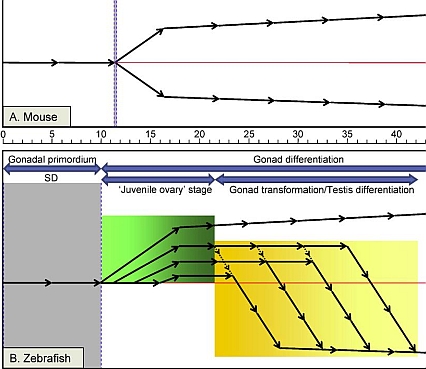Sex Determination and Differentiation
About this project
Project information
Project status
In progress
Contact
Research subject
Research environments
In mammals, sex determination is usually dependent on sex specific chromosomes. While this is also the case in many fish species there are species, such as the zebrafish do not appear to have sex chromosomes and where the mechanism of sex determination and differentiation remains poorly understood.
During early embryonic development zebrafish pass through a juvenile ovarian stage. The signals leading to the final transformation to testis or the maintenance of ovaries remain poorly understood. However the process of testis differentiation requires apoptosis in order to remove the early ovarian tissue and make place for the development of a testis.
Indeed, the first visible sign of testis development is the appearance of apoptotic oocytes within juvenile ovaries, forming cavities that serve as primary locations for early testis development. In addition, depletion of primordial germ cells in zebrafish results in masculinization, as shown in other species such as the Japanese medaka, chicken and some mammals. While these studies indicate that zebrafish has a complex system for sex determination and gonad differentiation, the mechanisms remain to be elucidated. Our focus is on the role of apoptotic signaling during differentiation of the zebrafish gonad. We are therefore studying the role of NFκB and its down-stream genes in the regulation of gonadal differentiation.

Selected publications
Pradhan A, Olsson PE. 2014. Juvenile ovary to testis transition in zebrafish involves inhibition of ptges. Biol Reprod. 91(2):33, 1-15
Reyhanian Caspillo N, Volkova K, Hallgren S, Olsson PE, Porsch-Hällström I. 2014. Short-term treatment of adult male zebrafish (Danio Rerio) with 17α-ethinyl estradiol affects the transcription of genes involved in development and male sex differentiation. Comp Biochem Physiol C Toxicol Pharmacol. 164:35-42
Pradhan A, Khalaf H, Ochsner SA, Sreenivasan R, Koskinen J, Karlsson M, Karlsson J, McKenna NJ, Orbán L, Olsson PE. 2012. Activation of NF-κB protein prevents the transition from juvenile ovary to testis and promotes ovarian development in zebrafish. J Biol Chem. 287(45):37926-38.
Orban, L., Sreenivasan, R., Olsson P.-E. (2009) Long and winding roads: Testis differentiation in zebrafish. Mol Cell. Endocrinol. 312, 35-41.
von Hofsten, J and Olsson, P.-E. (2005) Zebrafish sex determination and differentiation: involvement of FTZ-F1 genes. Reprod Biol Endocrinol. 3:63.
Koskinen, J., Karlsson, J., Olsson, P.-E. (2009) Sox9a regulation of ff1a in zebrafish (Danio rerio) suggests an involvement of ff1a in cartilage development. Comp. Physiol. Biochem. A Molecular and Integrative physiology. 153, 39?43
von Hofsten, J., Modig, C., Larsson, A., Karlsson, J. and Olsson, P.-E. (2005) Determination of the expression pattern of the dual promoter of zebrafish fushi tarazu factor-1a following microinjections into zebrafish one cell stage embryos. Gen. Comp. Endocrinol. 142, 222-226.
von Hofsten, J., Larsson, A. and Olsson, P.-E. (2005) A novel functional Steroidogenic factor-1 homologue (ff1d) is co-expressed with anti-Mullerian hormone (AMH) in zebrafish. Dev. Dyn. 233, 595-604.


